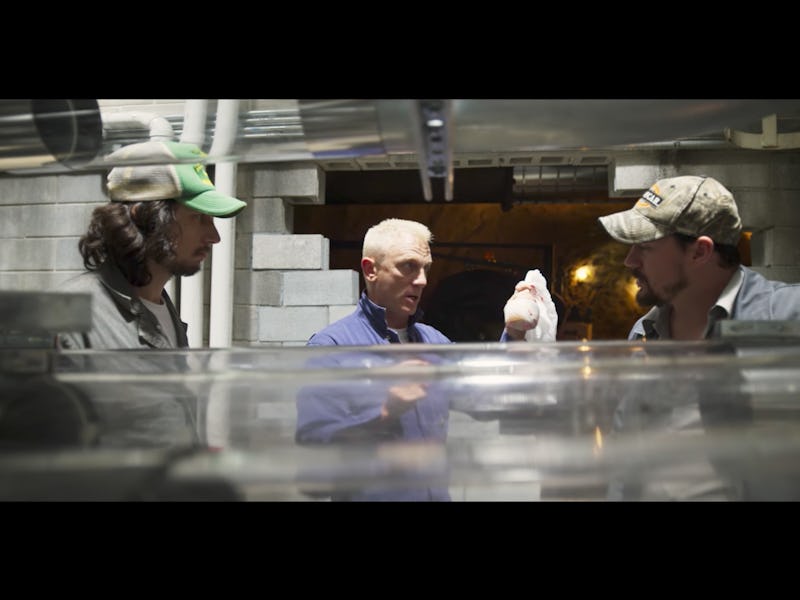Daniel Craig's Logan Lucky Bomb Is Basic High School Chemistry

In Logan Lucky, an unlikely team of downtrodden protagonists devises a seemingly impossible plan to get rich by robbing an unlikely target: the Charlotte Motor Speedway. In Steven Soderbergh’s blue-collar reply to Ocean’s Eleven, a team of resourceful West Virginians pools its physical and intellectual resources to attempt this high-stakes heist.
One member of the team is Joe Bang, a bleached-blonde safe-cracker played by Daniel Craig. Soderbergh hilariously stops the action in the middle of the film for Bang to provide an amateur chemistry lesson on the art of bomb-making, which proves to be noticeably less smart than the rest of the film.
Spoilers below for Logan Lucky. Also, this article contains explanations of the chemistry behind a homemade explosive device. Please do not attempt to copy the dangerous stuff you see in a heist movie about country dudes robbing a race track.
The speedway heist in 'Logan Lucky' relies on an explosive device to give our heroes access to the vault.
The team’s scheme to rob a NASCAR motorsports complex involves extracting money directly through the concession stands’ pneumatic tubes used for cash register drops. In a pivotal scene, the Logan brothers watch as Joe Bang builds a homemade explosive device from a seemingly innocent clutch of materials: bleach pens, salt substitute, gummy bears, and a plastic grocery bag.
This may sound more like your grandmother’s shopping list than a bomb-maker’s arsenal, but when Joe Bang mixes the ingredients in the plastic bag, twists it shut, and sends the package down the tube, the explosion and smoke tell a different tale.
While Joe Bang's bomb makes for a fun scene, it's not good science.
For all its violence, it’s actually a reaction that’s often demonstrated in chemistry classrooms using common laboratory chemicals. The active ingredient in household bleach is sodium hypochlorite (abbreviated as NaClO). Salt substitute contains potassium chloride (KCl). Combining these two chemicals yields potassium chlorate (KClO3), a strong oxidizing agent and a common ingredient in fireworks. When sucrose — the sugar found in gummy bears — is combined with molten potassium chlorate, the resulting thermal decomposition creates a rapid expansion of gases, as shown in the video below.
If this occurs inside an enclosed container, the container will eventually explode.
But this scenario almost certainly wouldn’t go down the way the film depicts.
First of all, the materials Joe Bang uses in his bomb are not pure, lab-grade chemicals. While household bleach does contain sodium hypochlorite, it’s a solution diluted to a concentration of about six percent — in other words, it’s mostly water. So, even though some quantity of the active ingredient would combine with the potassium chloride in the salt substitute to yield some quantity of potassium chlorate, there would still be a bunch of water in the mix.
Furthermore, combining these two chemicals at room temperature is unlikely to result in a complete reaction; in high school experiments, the mixture is typically heated and stirred to produce potassium chlorate. Joe Bang mixes up his explosive device by squeezing the bag, but it’s not likely that doing so would provide enough energy to result in a complete reaction.
Even if combining the bleach with salt substitute yielded sufficiently pure potassium chlorate, simply mixing it with gummy bears at room temperature probably wouldn’t be enough to make it go boom, as it does in the film. The process of thermal decomposition requires sufficient activation energy to begin, and this energy takes either the form of heat — whether by melting the crystalline potassium chlorate before adding sucrose or by igniting it after mixing the sugar — or a chemical catalyst, such as sulfuric acid.
In Logan Lucky, however, neither of these factors are present. In fact, when Joe Bang attempts to explain what happened when the explosive device fails to combust, his theory — that he twisted the plastic bag too many times — simply doesn’t make sense.
It is possible — though this possibility is very remote — that a strong enough impact could produce the activation energy necessary to catalyze this reaction, but you’d be hard-pressed to argue that this is what happens onscreen. So, despite the convincing makeshift chemistry lecture Joe Bang delivers beneath the Charlotte Motor Speedway, it’s safe to say that his explosive device probably wouldn’t work.
That being said, please don’t try to replicate this device at home. It can’t be stressed enough. If your efforts are successful, your explosive device will be unstable and unpredictable at best.